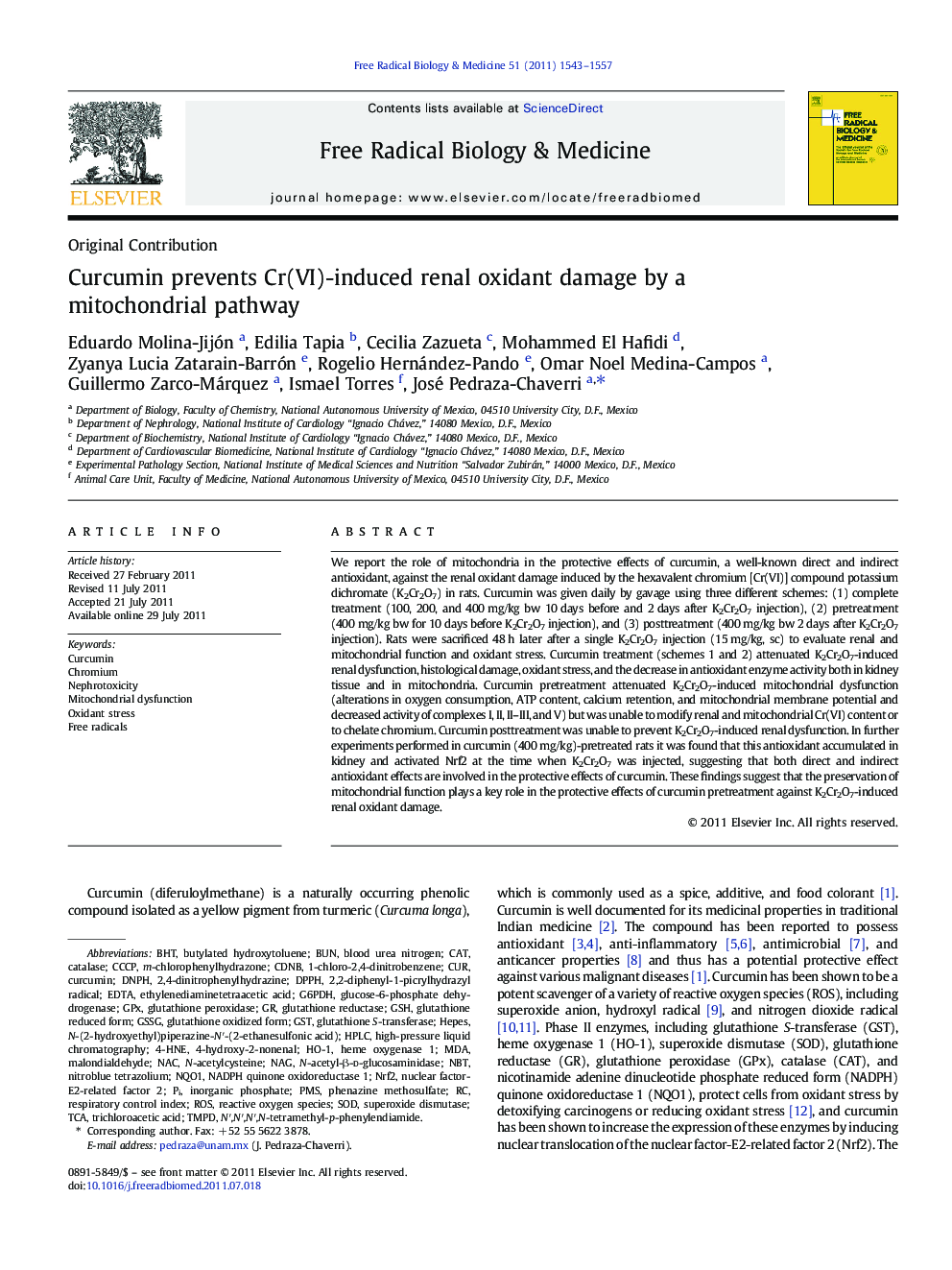| Article ID | Journal | Published Year | Pages | File Type |
|---|---|---|---|---|
| 10738361 | Free Radical Biology and Medicine | 2011 | 15 Pages |
Abstract
We report the role of mitochondria in the protective effects of curcumin, a well-known direct and indirect antioxidant, against the renal oxidant damage induced by the hexavalent chromium [Cr(VI)] compound potassium dichromate (K2Cr2O7) in rats. Curcumin was given daily by gavage using three different schemes: (1) complete treatment (100, 200, and 400Â mg/kg bw 10Â days before and 2Â days after K2Cr2O7 injection), (2) pretreatment (400Â mg/kg bw for 10Â days before K2Cr2O7 injection), and (3) posttreatment (400Â mg/kg bw 2Â days after K2Cr2O7 injection). Rats were sacrificed 48Â h later after a single K2Cr2O7 injection (15Â mg/kg, sc) to evaluate renal and mitochondrial function and oxidant stress. Curcumin treatment (schemes 1 and 2) attenuated K2Cr2O7-induced renal dysfunction, histological damage, oxidant stress, and the decrease in antioxidant enzyme activity both in kidney tissue and in mitochondria. Curcumin pretreatment attenuated K2Cr2O7-induced mitochondrial dysfunction (alterations in oxygen consumption, ATP content, calcium retention, and mitochondrial membrane potential and decreased activity of complexes I, II, II-III, and V) but was unable to modify renal and mitochondrial Cr(VI) content or to chelate chromium. Curcumin posttreatment was unable to prevent K2Cr2O7-induced renal dysfunction. In further experiments performed in curcumin (400Â mg/kg)-pretreated rats it was found that this antioxidant accumulated in kidney and activated Nrf2 at the time when K2Cr2O7 was injected, suggesting that both direct and indirect antioxidant effects are involved in the protective effects of curcumin. These findings suggest that the preservation of mitochondrial function plays a key role in the protective effects of curcumin pretreatment against K2Cr2O7-induced renal oxidant damage.
Keywords
NADPH quinone oxidoreductase 1DNPHNrf2TCAGSHGSTMDAGPXHO-1NACGSSGNBTCDNBNuclear factor-E2-related factor 2CCCPNAGNQO1G6PDHCAT4-HNEPMSTMPDCURHEPESBHTDPPH1-chloro-2,4-dinitrobenzene2,2-diphenyl-1-picrylhydrazyl radical2,4-dinitrophenylhydrazine4-hydroxy-2-nonenalN-(2-hydroxyethyl)piperazine-N′-(2-ethanesulfonic acid)N-acetyl-β-d-glucosaminidaseN-acetylcysteineROSnitroblue tetrazoliumEDTAEthylenediaminetetraacetic acidMitochondrial dysfunctionOxidant stresstrichloroacetic acidBUNFree radicalsSODSuperoxide dismutaseRespiratory control indexglutathione oxidized forminorganic phosphatephenazine methosulfatemalondialdehydeNephrotoxicityblood urea nitrogenheme oxygenase 1butylated hydroxytolueneCatalaseChromiumhigh-pressure liquid chromatographyHPLCCurcuminglutathione S-transferaseglutathione reductaseglutathione reduced formglutathione peroxidaseglucose-6-phosphate dehydrogenaseReactive oxygen species
Related Topics
Life Sciences
Biochemistry, Genetics and Molecular Biology
Ageing
Authors
Eduardo Molina-Jijón, Edilia Tapia, Cecilia Zazueta, Mohammed El Hafidi, Zyanya Lucia Zatarain-Barrón, Rogelio Hernández-Pando, Omar Noel Medina-Campos, Guillermo Zarco-Márquez, Ismael Torres, José Pedraza-Chaverri,
